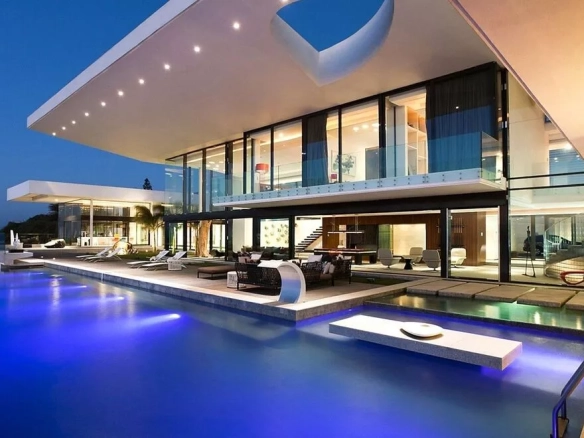World’s most innovative building materials 2023
- Home
- Luxury Interiors
- World’s most innovative building materials 2023
LATEST BLOGS
In the construction industry, materials and technology are often perceived as separate entities. However, we have taken a significant leap forward by integrating conventional materials with cutting-edge technology to create advanced construction materials. Not only are these materials highly efficient, but they also prioritize environmental sustainability. Traditionally, materials and technology have been treated as distinct components within the construction sector. Yet, we have embraced a new approach that merges the two, resulting in the development of groundbreaking construction materials. By harnessing the power of technology, we have unlocked a realm of possibilities that enhance the efficiency and effectiveness of these materials.
These advanced construction materials offer numerous advantages. Firstly, their efficiency surpasses that of conventional materials, enabling us to construct buildings and infrastructure with greater speed and precision. By leveraging technology, we have optimized the performance of these materials, allowing for seamless integration and enhanced functionality. Moreover, environmental sustainability lies at the core of our innovation. These new materials are designed with a strong commitment to reducing our ecological footprint. By incorporating eco-friendly elements and practices, we ensure that our construction processes align with the principles of sustainability. This not only benefits the environment but also contributes to the overall well-being of our communities.
In conclusion, the integration of materials and technology in the construction industry has revolutionized the way we build. Our advanced construction materials not only exhibit exceptional efficiency but also prioritize environmental sustainability. By embracing this innovative approach, we are shaping a future where construction practices are both cutting-edge and environmentally responsible.
Why do we need advanced construction materials?
When you think of “construction materials,” what comes to mind? Timber, steel, or bricks, perhaps? Well, get ready to expand your horizons because there’s a whole new world of innovative materials out there. Imagine light-generating concrete, bioplastic, or strand rods. These cutting-edge materials are revolutionizing the construction industry, allowing architects to bring their visions to life and engineers to construct structures in never-before-seen forms and techniques.
The materials we rely on today, both renewable and nonrenewable, have their limitations. Non-renewable materials, in particular, pose a risk of depletion in the future. On the other hand, renewable materials offer a more sustainable option, but we must be cautious not to harm the environment in the process of obtaining them from nature.
Fortunately, intensive research and analysis have led to the development of these advanced materials, addressing various challenges faced in construction. While many of these materials are not yet widely used in the industry, we can expect this to change as they become more affordable and accessible.
In conclusion, the world of construction materials is evolving, and these new innovations are paving the way for a more exciting, professional, and sustainable future in the industry.
The most innovative construction materials in the world 2023
TRANSPARENT WOOD

The announcement of the latest eco-friendly material, transparent wood, was made in 2016. However, it wasn’t until 2020 that the scientist, in collaboration with a team from the University of Maryland at College Park, declared the completion of tests and the achievement of a stable result. Transparent wood boasts a strength and lightness at least five times greater than glass, making it an intriguing potential replacement for plastic or glass windows. Additionally, it offers enhanced thermal efficiency.
One of the key advantages of transparent wood is its renewable and eco-friendly nature. The balsa tree, from which it is derived, grows rapidly, reaching maturity in just five years. Moreover, production costs are significantly lower compared to glass production, which involves high temperatures and electricity consumption, resulting in a noticeable carbon footprint.
Transparent wood exhibits remarkable flexibility due to its natural cellulose content. To achieve transparency, balsa wood is immersed in a special solution and then fortified with epoxy resin. This innovative material, also known as wooden glass, can be utilized in place of traditional glass units or other transparent elements in building structures. It offers durability, eco-friendliness, and energy efficiency.
By combining strength, lightness, thermal efficiency, and sustainability, transparent wood presents an exciting breakthrough in the field of materials science. Its potential applications in various industries, particularly in construction, hold promise for a greener and more sustainable future.
SELF-HEALING CONCRETE

Introducing a groundbreaking innovation, a novel form of concrete that mimics the remarkable healing process of the human body. By incorporating specific materials, this concrete possesses the ability to self-repair, just like our bodies do after sustaining wounds. The secret lies in the inclusion of adhesive liquids within the concrete mix, either through the addition of fibers or capsules. When cracks occur, these capsules or fibers rupture, releasing the restorative fluids and effectively healing the concrete.
It is important to note that this technology is currently in the research phase, showcasing its immense potential for future development. The implications of this automatic healing capability are profound, as it promises to significantly extend the lifespan of concrete structures while simultaneously reducing the costs associated with repairs. Cracks that expand and reach the reinforcement can lead to corrosion, posing a serious threat to the integrity of the structure. However, the implementation of self-healing concrete effectively prevents such deterioration from occurring.
By harnessing the innate healing mechanisms found in nature, this innovative concrete represents a paradigm shift in the construction industry. Its ability to autonomously repair itself not only ensures the longevity of concrete structures but also enhances their durability and resilience. As this technology continues to advance, it holds the potential to revolutionize the way we build and maintain our infrastructure, ushering in a new era of sustainable and cost-effective construction practices.
POWER GENERATING GLASS

Energy use in built spaces is a significant concern, given that buildings are responsible for a staggering 40% of global carbon emissions. However, a groundbreaking solution has emerged: power-generating glass. While solar and wind systems have long been utilized, the concept of transforming windows into solar panels has now become a reality. Power-generating glass, which closely resembles regular glass, possesses the remarkable ability to deflect invisible light wavelengths and convert them into usable energy. By harnessing this innovative technology, not only can we reduce electricity costs and minimize pollution, but we can also enhance the architectural appeal of structures.
Transparent aluminium

This material has gained significant recognition as a material of the future, even making an appearance in the renowned 1986 Star Trek movie! However, there is a notable distinction between the movie version and the real-world material we possess today. In the film, transparent aluminium is depicted as being composed solely of pure elemental aluminium, whereas in reality, it is a ceramic alloy. Nevertheless, this real-world transparent aluminium is incredibly robust and believed to be highly resistant to corrosion and oxidation. As a result, it is currently employed in the production of bulletproof glass and various security systems.
Regrettably, the main drawback of this remarkable material is its cost, which surpasses that of conventional bulletproof glass by a significant margin. Nonetheless, as the price eventually decreases, we can anticipate a widespread utilization of this extraordinary substance in applications such as windows, facades, and even underwater structures. Transparent aluminium may very well emerge as the cost-effective and long-lasting solution that the construction industry desperately requires in the present day.
These cutting-edge construction materials have introduced a realm of possibilities within the AEC industry, paving the way for a more sustainable future characterized by efficient construction practices and reduced pollution. Although some of these materials have yet to gain widespread adoption, it is undeniable that technological innovation will undoubtedly reshape the landscape in the near future.
SENSITILES — DECORATIVE ACRYLIC TILE

Innovative building materials encompass more than just those with exceptional physical properties such as strength and safety. They can also include materials that incorporate technology to offer stunning decoration and enable the realization of extravagant design concepts.
One such groundbreaking building material is the sensitive tile, which features acrylic fiber that responds to movements, touch, and light sources. Through the use of optical fiber, these tiles transmit light and react accordingly, resulting in twinkling effects, illumination, and the reflection and dispersion of neighboring colors on their surface. The utilization of this material opens up exciting possibilities in the fields of architecture and interior design.
LIGHT GENERATING CEMENT

According to a study conducted by UMSNH of Morelia, it has been discovered that concrete possesses the remarkable ability to absorb and radiate light, thereby enhancing its functionality and versatility in terms of energy efficiency. This groundbreaking development in the form of light-generating cement opens up a plethora of potential applications. For instance, it can be effectively utilized in various areas such as parking lots, swimming pools, and road safety signs.
The production process involves modifying the microstructure of cement to enable it to absorb solar energy during the day and emit light during the night, illuminating the surroundings. At present, the available colors for light-generating cement are blue and green, and the intensity of the emitted light can be easily adjusted by contractors to meet specific requirements.
LIQUID GRANITE

Artificial “liquid” stone is a unique construction mixture that combines 70% marble chips with 30% special additives and decorative filler. This innovative blend is then sprayed onto various surfaces such as concrete, brickwork, stone, and asphalt. The liquid swiftly solidifies, creating a robust seal that not only enhances durability but also adds an appealing aesthetic to the surface.
One of the remarkable aspects of liquid granite is its eco-friendly nature. It incorporates safe resins, natural marble chips, and mineral fillers, making it a sustainable choice. This composite material finds extensive use in finishing works, whether it be for manufacturing or coating individual structures or interior elements.
By utilizing this cutting-edge liquid stone, construction projects can achieve both functionality and visual appeal. The combination of marble chips and additives creates a seamless and long-lasting finish, ensuring the surface remains intact for an extended period. Moreover, the environmentally conscious composition of liquid granite aligns with the growing demand for sustainable construction materials.
Whether it’s enhancing the appearance of concrete walls, revamping brickwork, or rejuvenating stone and asphalt surfaces, artificial liquid stone offers a versatile solution. Its ability to congeal into a tight seal not only provides durability but also adds a touch of elegance to any structure or interior space.
LAMINATED WOOD

This material represents a groundbreaking innovation that harnesses the power of wood in its entirety. By pressing the wood into panels and laminating them, it transforms into a robust block that surpasses the strength of ordinary wood.
Within this remarkable category, we encounter sub-types such as cross-laminated timber and laminated wood. Laminated wood comprises multiple pieces of lumber expertly glued together, resulting in the creation of sturdy beams. On the other hand, cross-laminated timber involves laying pieces of wood in alternating directions, forming expansive panels capable of withstanding substantial loads. Remarkably, both variations exhibit exceptional fire resistance. When exposed to flames, the outer layers of these materials undergo charring, which effectively insulates the remaining wood. In rigorous fire resistance tests, they have consistently demonstrated their ability to maintain structural integrity.
Moreover, the utilization of solid wood not only offers remarkable strength but also contributes to carbon capture. As trees grow, they naturally absorb carbon dioxide from the atmosphere, and this process continues even after the wood is incorporated into buildings. A study published in the esteemed Journal of Sustainable Forestry highlights the potential of sustainable forestry practices in preventing a significant portion of global emissions. By replacing conventional building and bridge materials with wood, it is estimated that 14 to 31% of global emissions can be mitigated.
In summary, this innovative material harnesses the full potential of wood, creating a solid block that surpasses the strength of ordinary wood. With sub-types like cross-laminated timber and laminated wood, it offers exceptional fire resistance and structural integrity. Furthermore, the use of solid wood facilitates carbon capture, making it an environmentally conscious choice. By embracing sustainable forestry practices and incorporating wood into construction projects, we have the opportunity to significantly reduce global emissions and build a more sustainable future.
POLLUTION ABSORBING BRICKS

Sustainability in construction is a matter of great concern due to the escalating population density and pollution levels. These pressing challenges have compelled the industry to seek sustainable solutions. One such solution is the utilization of pollution-absorbing bricks, which effectively filter the external air and supply it to the interior of structures. These bricks are specifically designed as porous concrete blocks with faceted surfaces that direct airflow into a system. Not only are these bricks cost-effective compared to mechanical filtration technologies, but they also consume less energy and do not necessitate skilled labor for construction.
By incorporating pollution-absorbing bricks into construction practices, we can address the environmental impact of the industry while simultaneously enhancing the quality of indoor air. These bricks serve as a practical and efficient alternative to traditional filtration methods, offering a sustainable approach to combatting pollution. Moreover, their affordability and ease of installation make them an attractive choice for builders and developers seeking to incorporate sustainable practices into their projects.
The benefits of pollution-absorbing bricks extend beyond their environmental impact. By reducing the reliance on mechanical filtration systems, we can significantly decrease energy consumption, resulting in cost savings and a reduced carbon footprint.
In conclusion, pollution-absorbing bricks represent a promising innovation in the construction industry’s pursuit of sustainability. Their ability to filter air, affordability, energy efficiency, and ease of installation make them an ideal choice for addressing the challenges posed by increasing population density and pollution. By embracing such sustainable solutions, we can pave the way for a greener and more environmentally conscious future in construction.




